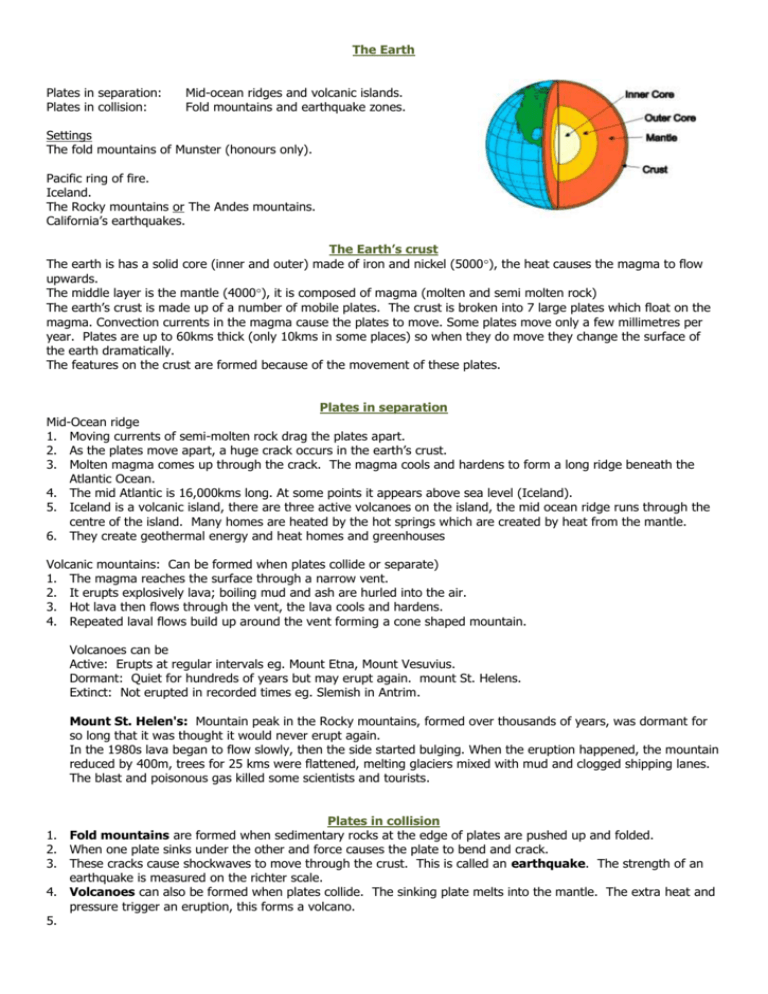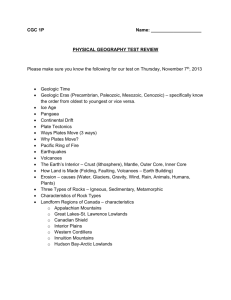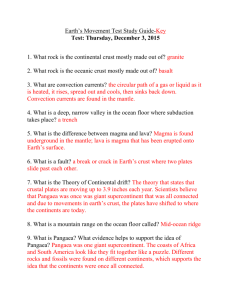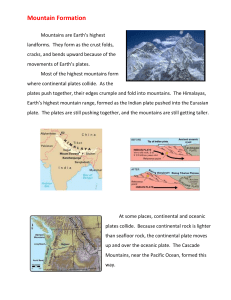The Earth - St. Angela`s College Geography
advertisement

The Earth Plates in separation: Plates in collision: Mid-ocean ridges and volcanic islands. Fold mountains and earthquake zones. Settings The fold mountains of Munster (honours only). Pacific ring of fire. Iceland. The Rocky mountains or The Andes mountains. California’s earthquakes. The Earth’s crust The earth is has a solid core (inner and outer) made of iron and nickel (5000°), the heat causes the magma to flow upwards. The middle layer is the mantle (4000°), it is composed of magma (molten and semi molten rock) The earth’s crust is made up of a number of mobile plates. The crust is broken into 7 large plates which float on the magma. Convection currents in the magma cause the plates to move. Some plates move only a few millimetres per year. Plates are up to 60kms thick (only 10kms in some places) so when they do move they change the surface of the earth dramatically. The features on the crust are formed because of the movement of these plates. Plates in separation Mid-Ocean ridge 1. Moving currents of semi-molten rock drag the plates apart. 2. As the plates move apart, a huge crack occurs in the earth’s crust. 3. Molten magma comes up through the crack. The magma cools and hardens to form a long ridge beneath the Atlantic Ocean. 4. The mid Atlantic is 16,000kms long. At some points it appears above sea level (Iceland). 5. Iceland is a volcanic island, there are three active volcanoes on the island, the mid ocean ridge runs through the centre of the island. Many homes are heated by the hot springs which are created by heat from the mantle. 6. They create geothermal energy and heat homes and greenhouses Volcanic mountains: Can be formed when plates collide or separate) 1. The magma reaches the surface through a narrow vent. 2. It erupts explosively lava; boiling mud and ash are hurled into the air. 3. Hot lava then flows through the vent, the lava cools and hardens. 4. Repeated laval flows build up around the vent forming a cone shaped mountain. Volcanoes can be Active: Erupts at regular intervals eg. Mount Etna, Mount Vesuvius. Dormant: Quiet for hundreds of years but may erupt again. mount St. Helens. Extinct: Not erupted in recorded times eg. Slemish in Antrim. Mount St. Helen's: Mountain peak in the Rocky mountains, formed over thousands of years, was dormant for so long that it was thought it would never erupt again. In the 1980s lava began to flow slowly, then the side started bulging. When the eruption happened, the mountain reduced by 400m, trees for 25 kms were flattened, melting glaciers mixed with mud and clogged shipping lanes. The blast and poisonous gas killed some scientists and tourists. Plates in collision 1. Fold mountains are formed when sedimentary rocks at the edge of plates are pushed up and folded. 2. When one plate sinks under the other and force causes the plate to bend and crack. 3. These cracks cause shockwaves to move through the crust. This is called an earthquake. The strength of an earthquake is measured on the richter scale. 4. Volcanoes can also be formed when plates collide. The sinking plate melts into the mantle. The extra heat and pressure trigger an eruption, this forms a volcano. 5. Fold mountains When 2 plates collide, the rocks tend to buckle upwards and arch into upfolds and downfolds. The world’s youngest mountains include the Alps, the Rocky Mountains (Pacific and American plate collided) and the Himalayas. They were formed during the Alpine foldings about 35 million years ago. They are still very high because they have not become as older fold mountains. Ireland’s fold mountains were formed millions of years ago. These are so old that they have been worn down to quite low heights. Our most recently folded mountains occur throughout Munster. They were formed during the Armorican foldings about 250 million years ago when the Eurasian and African plates collided. Eg Magillicuddy'r reeks, Galtees, knockmealdowns. Earthquakes An earthquake is the sudden shaking rolling or shock of the Earth’s surface. They happen where plates collide or slide past each other The Focus is the place beneath the earth’s surface where the earthquake occurs. The Epicentre is the spot on the surface directly above the focus. Tremors move out from the epicentre like ripples in a pool. 5. San Francisco in the U.S.A has suffered severe earthquakes because it is where the American and Pacific plates collide. It is located along a fault called the San Andreas Fault. 6. The force of an earthquake is measured on the Richter scale. 7. A seismograph is the instrument to measure the force of an earthquake. 1. 2. 3. 4. The Sichuan earthquake of 2008 measured 7.9 on the Richter scale, followed by 50 aftershocks. The plates moved up to 9m. Caused by the Indian plate pushing the Eurasian plate. 70,000 killed (including 10,000 children). 5m made homeless. 12 m animals killed, diseases spread and communications were blocked. Tsunami: A giant wave caused by underwater earthquakes. in 2004 the Indian plate pushed under the Eurasian plate. The wave was up to 30m high and travelled at 800kms per hour. 200,000 killed and 1 million made homeless. Tourism wiped and communities destroyed. Pacific ring of fire The largest number of volcanoes and earthquakes occur around the rim of the Pacific ocean where the edges of many large crustal plates meet. Many of these volcanoes are active so this zone is called the Pacific Ring of Fire. Read the information above carefully. For each heading you should look at the maps in your book and the diagrams for each feature. If you are unsure of the diagrams you need to draw them onto this revision sheet. When you have studied the information see if you can answer the questions below. Remember the format: STATEMENT – DEVELOPMENT – EXAMPLE Questions: 1. Explain how the plates of the Earth’s crust move. 2. What features are formed when plates collide? 3. What features are formed when plates separate? 4. Explain using a clearly labelled diagram how a volcano is formed. 5. Explain using a clearly labelled diagram how a fold mountain is formed. 6. Describe what happens when an earthquake occurs, in you answer refer to one city you have studied. 7. Using one specific example you have studied explain the advantages and disadvantages of a volcanic island. Now go to studyclix.ie. Select Junior cert geography, then higher level, finally the section on the Earth and plates. Attempt each question then check your answers. If you come across a question you can't do, ask in class.






